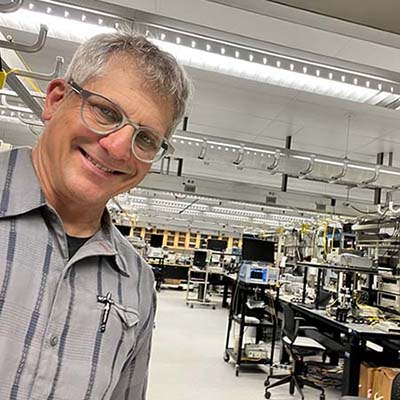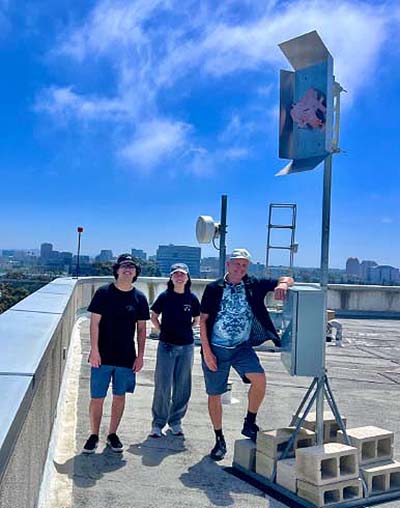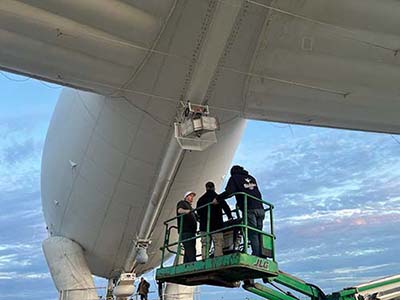UC San Diego Startup Incubator Helps Company Expand Wireless Reach
World Mobile is leveraging talent and facilities at UC San Diego to bring connectivity to underserved areas
Story by:
Published Date
Article Content
Telecommunications company World Mobile, which aims to bring internet connectivity to underserved areas in the U.S. and abroad, recently announced the launch of operations in Reno, Nevada, using innovative technology designed and built at the University of California (UC) San Diego Qualcomm Institute (QI).
“Surprisingly, the cell towers that you see all over the place are very kludgy,” said Stuart Volkow, program manager for World Mobile and former staff member at UC San Diego’s Center for Astrophysics and Space Sciences (now Department of Astronomy and Astrophysics). “As the mainstream providers, they use pretty standard technology. So there’s a lot of room to innovate in that area to make the antennas more efficient and for different use cases, which is what we’ve been doing at QI.”

World Mobile, a company founded in 2018 and headquartered in London, England, is aiming to provide wireless service in areas that currently don’t attract mainstream providers due to their remote locations or sparse populations. And the company’s team wants to do it in a way that’s more affordable for end users than satellite services.
“The problem World Mobile is solving has global implications,” said Volkow, who cited a 2021 report from the International Telecommunication Union stating that 2.6 billion people, or about a third of the world’s population, are still offline; many others, including in some rural areas in the U.S., receive sub-optimal service. “Those without are doomed to relative poverty.”
To fill the gaps in connectivity, the company is innovating on a number of levels. It is taking a novel approach to its antennae platforms, which include blimps (a.k.a. airships, balloons or aerostats) floating up to 3,500 feet while tethered to the ground. The elevation allows wireless signals to reach a large radius — the equivalent of a dozen or more towers. These stations can be combined with smaller nodes that provide high capacity.
World Mobile’s business model is also unusual — it gives individuals the opportunity to buy and/or host wireless antennae and to then share in the proceeds. This entry into the sharing economy is made possible by blockchain software that allows detailed tracking of signal usage for each station.
And, on the UC San Diego campus, the company is taking a fresh look at antenna design.
Optimizing antennas with AI
As part of the QI Innovation Space program for the last year, World Mobile has leveraged QI’s Atkinson Hall facilities — including its Circuits Lab and rooftop antenna garden — and access to UC San Diego talent to design, fabricate and test novel wireless equipment to mount on the blimps.

“The Qualcomm Institute circuits and millimeter wave lab is well suited for this work,” said World Mobile Chief Architect James Tagg. “The Atkinson Hall rooftop antenna farm provides an excellent place to test our antennas with connectivity to instruments at our lab bench. We’ve been able to recruit a great team of both undergraduate and graduate students that have worked on design, fabrication, simulation and deployment and work with uniquely qualified faculty and staff.”
On the faculty side, telecommunications industry veteran John Sanford, professor of practice in the UC San Diego Jacobs School of Engineering Department of Electrical and Computer Engineering, is advising the team. His approach looks to artificial intelligence (AI) to help design antennas that have a greater range and cover different radio spectrum bands more efficiently than standard technology.
“Using neural networks and other AI techniques, we can accelerate the way we optimize antennas,” Sanford said. “We are achieving greater range, over more frequencies, that can be deployed around the world in a wide variety of configurations.”
The team’s work on antennas developed at QI was written up as a paper, “Unique Airborne Wireless Communication System for Connecting the Unconnected,” which is being submitted to this fall’s Institute of Electrical and Electronics Engineers (IEEE) International Symposium on Phased Array Systems and Technology conference in Boston. In addition to Sanford, Tagg and Volkow, co-authors included UC San Diego student interns Nick Ratto ’24, Zachary Bohedba ’24 and Rachel Hartanto ’25 (all mechanical and aerospace engineering students) and Siddharth Mohan ’23 (electrical and computer engineering).
Ratto recalled his surprise when he first saw the shape of the AI-designed antenna. “I was expecting some level of symmetry and smoothness,” he said. “Instead, it’s this strange organic shape — it looks like what you’d get if you gave a piece of paper and scissors to a toddler!”
The interns have contributed to the company’s progress and have gained invaluable experience in the process.
Launch to the sky
Using the UC San Diego Makerspace, Ratto, Mohan, Bohedba and Hartanto created the antenna from thin copper sheets and mounted them on aluminum reflectors. Following encouraging results from tests on the Atkinson Hall rooftop, Ratto conferred with airship engineers. Then he designed a way to mount the antennae on the blimp.

“I got to work on one of the balloons, put stuff on, and see it launch to the sky,” said Ratto, who attended a field test of the equipment. “I could see the parts I made.”
Ratto easily rattles off a list of benefits of his internship with World Mobile. These include “working with really, really smart people”; learning about the telecommunications industry and what it takes to be an antenna engineer; and becoming comfortable figuring out how to do things without explicit instructions, “learning how to learn on the fly.”
Most importantly, perhaps, he found out what kind of work environment excites him: “The most important thing I learned was how much I like seeing the stuff I make become real, being part of the entire process. Teamwork with a team that works well together is so fulfilling.”
World Mobile’s antenna development at QI will continue with a focus on novel arrays for the 850 Mhz spectrum for 5G deployments in countries around the world.
Learn more about the QI Innovation Space and World Mobile.
Learn more about research and education at UC San Diego in: Artificial Intelligence
You May Also Like
Engineers Take a Closer Look at How a Plant Virus Primes the Immune System to Fight Cancer
Technology & EngineeringStay in the Know
Keep up with all the latest from UC San Diego. Subscribe to the newsletter today.




